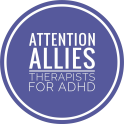Despite intelligence and creativity, many people with ADHD struggle to thrive in systems not built for their neurotype. In this article, Attention Allies counsellor Rebecca Burton suggests it’s time to rethink learning, productivity and support – starting with approaches that align with how ADHD brains actually work.
(4 minute read)
My father had an IQ of over 140 yet age 50 was dismissed from his job for forgetting to fill out paperwork. His family used to say, “What happened to him?”, faces drooping with sadness and a tone of regret. It’s such a familiar refrain for adults who have lived with undiagnosed ADHD that it’s almost a cliché, the school report that says “Could do better” and the accusations of laziness. It would be good to think this has got better, but I’ve recently heard of children with ADHD diagnoses described by teachers as “just lazy” and that “they can do it if they want to”.
I come across many people in my practice who live with a daily and constant sense of frustration, fully aware of their creativity, their highly tuned capacity to recognise patterns and use them to predict the future, their ability to make unusual and interesting connections at lightning speed, and also their fundamental inability to bring these talents into the world, not just because they lack executive function – though they do – but because the world does not yet routinely teach how to learn for the ADHD mind/brain.
It’s more or less commonly understood now that people with ADHD have low dopamine, a brain hormone that makes connections between neurons or nodules, in the brain. It’s what makes the brain “work”. Low levels of this hormone create a “slow brain”, which isn’t the same as saying “not very clever”; it’s more like saying that working memory and planning take more time than for someone in a high dopamine situation. So methods that take advantage of step-by-step approaches, or learning that begins with the basics or is simple and builds one step at a time, just aren’t easy for an ADHDer to access. When people (in general) are struggling, they are typically taught these kinds of methods. For example, if someone can’t draw a whole person at once, they might be encouraged to outline the basic shapes and build from there. The problem is that the ADHD mind/brain works better approaching something the other way around, with the finished product or the whole picture first, then extracting the needed information from that.
I remember at university shocking my tutors by not having a research question for a paper two weeks before the due date. I didn’t have a question but I did have an entire in-depth and fully annotated holographic research database in my mind. All I had to do was extract a single line of questioning and interrogate my database, and the essay would write itself. It did; I did well. But I didn’t have the language to explain that this is how my mind works. If I did, I would have saved all of us a lot of frustration and stress.
It seems that some ADHDers need to build a full picture of the topic they need information on, really milking their skills of creative thinking, experience-based intuition and ability to hyperfocus on things they are interested in, in order to do things that neurotypical people use their linear minds and executive function for. This is a different way of thinking, a different way of operating in the world. It applies to everything from a PhD thesis, to understanding a train timetable, to getting ready to leave the house. A large amount of context, hooking things to topics of interest (I make everything about visual aesthetics, for example, to get myself interested), and then working backwards, inwards from a bigger picture towards the detail that’s needed, rather than working forwards along a line where one thing leads logically to another.
Occasionally, this can take more time. However, I’m not sure that’s even an issue in and of itself; it’s more that we are not taught how to do this, so ADHD people are left fumbling along using the method inefficiently or fighting their natural tendencies, both of which take a lot of energy and create a lot of anxiety.
I think that if my dad had managed to get interested in note-taking, in using special stationery or in technological solutions, he might have saved himself from the humiliation of a sacking. But no one taught him how to do it.
The idea of creating workarounds that work for you is based on this kind of stuff. If you are often stressed by knowing you have all sorts inside you that you are unable to “get out”, if people are always underestimating you, if you are constantly berating yourself for being “lazy”, then it might be time to start thinking about what you need to work with your mind/brain rather than against it.
Click the link if you'd like to visit Rebecca's website or her directory entry on Attention Allies.
Published 23 April 2025
All rights reserved © Copyright Rebecca Burton 2025. Unauthorised use and/or duplication of this material without express and written permission from the author of this post is strictly prohibited. Author contact via website Contact page.
Website version and image © Copyright Attention Allies 2025.
